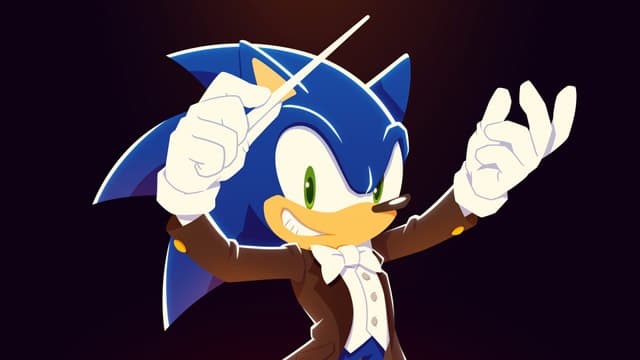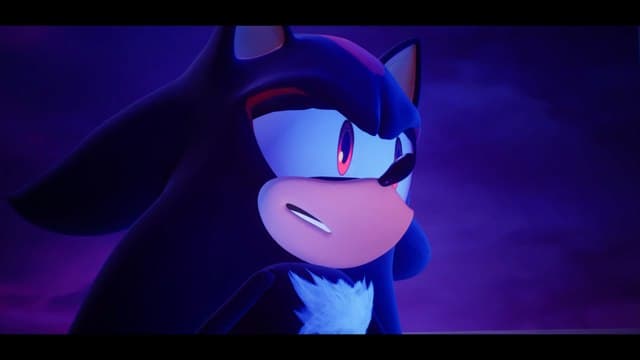It’s Sonic the Hedgehog’s 30th anniversary today, and what better way to pay tribute to the Blue Blur himself on his big day than by ignoring him entirely to talk about the real star of the show? Shadow the Hedgehog, Sonic’s rival who debuts in Sonic Adventure 2, has a birthday to celebrate too, because it’s also Sonic Adventure 2’s 20th anniversary week. Folks, I want Sega and Sonic Team to love my precious anti-hero son again. But in the years since he received his much-maligned solo game in 2005, it seems like both companies are willing to let him be the insufferable edgelord people always thought he was.
When Shadow first appeared as the “Dark” counterpart to Sonic, the black hedgehog was the introverted, brooding, loner foil to Sonic’s happy-go-lucky, impulsive nature. The contrasts between the two took clear inspiration from dynamics like Goku and Vegeta’s rivalry in Dragon Ball Z. For at least a few games, it actually struck a meaningful balance between the two. Shadow wasn’t an edgelord — he was just an enigmatic character with a tragic backstory and an ambiguous motive.

Shadow was created as part of an experiment researching immortality fifty years before Sonic’s time. He was to be the Ultimate Life Form. It was all to find a cure for Maria Robotnik, the terminally ill granddaughter of Shadow’s creator Dr. Gerald Robotnik, the grandfather of series antagonist Dr. Eggman. After government officials deemed the project too dangerous, the space station research facility where Shadow and Maria resided was raided, resulting in Maria’s death, while Shadow was sent down to Earth.
The hedgehog was awoken 50 years later by Dr. Eggman. With modified memories courtesy of his creator and vengeance in his heart, he hoodwinked both his allies and rivals into nearly destroying the entire world, before realizing this isn’t what Maria would have wanted. Undoing his own plan and saving the world nearly cost Shadow his life, but he reappeared in Sonic Heroes as an amnesiac in one of Dr. Eggman’s labs, with his connection to his previous life being told to him, rather than something he felt. He couldn’t remember his relationship with Maria or the characters he came to know in Sonic Adventure 2, like jewel thief Rouge the Bat. With the help of Rouge and their new robot friend E-123 Omega, Shadow seeks answers from Eggman about his memory and finds nothing but dead ends and more questions. Eggman even uses his likeness in a new line of androids to do his bidding, leaving the game on a surprisingly dark note for a mascot platform of the time: the Shadow we’ve been playing might not even be the real deal.
From Sonic Heroes onward, Shadow’s story became a tale of a character who had been created for a scientific breakthrough, repurposed as a weapon, and then used as a blueprint for a new wave of robots to do Dr. Eggman’s bidding. For a 50-year-old character, he’s spent most of his life being told he exists for purposes beyond his own autonomy. His heel turn at the end of Sonic Adventure 2 to go against the revenge scheme is one of the first times Shadow decided anything for himself. With Maria gone and Robotnik’s plans stopped, what purpose does Shadow’s life serve?

And that’s the thesis of his own game that launched in 2005, a game with so many bad ideas that it altered the character’s trajectory into an unrecognizable caricature of himself. This sucks because, in spite of itself, Shadow the Hedgehog’s exploration of a character trying to define their identity through uncovering their past is such an interesting foundation for a game with multiple endings. But the sloppy and abstract execution gets easily lumped in with the bad ideas of giving a hedgehog a gun and having him swear. There are choices made and missions completed, but the culmination of all of these is rarely reflected in the ending you obtain. As the entire thing has to be modular and can change from mission to mission. Each ending brings Shadow to a different conclusion about himself, but it’s hardly real character development. It’s just a “what if” scenario. It’s effective in what it’s trying to illustrate, but the getting there is arbitrary.
You may also like:
- Sonic the Hedgehog is Actually a Demon According to Shin Megami Tensei Mobile Game
- Sonic Being a Terrible Swimmer in Olympic Games Tokyo 2020: A Review
- Pitch: How Has There Never Been a Sonic the Hedgehog Rhythm Game?
Shadow the Hedgehog has a lot of the same running and jumping as a standard Sonic game, but its missions give each level a branching path. Each culminates in Shadow finding a specific handful of facts about his history, leading him to different interpretations of who he is and who he should be. On paper, it’s a fascinating look at how perspective and choice can lead us on a different trajectory. Unfortunately, it is surrounded by one of the worst gameplay experiences in the series’ 3D era.
The focus on firearms just makes matters worse, lacking anything comparable to third-person shooters at the time, all in the name of making a “mature” Sonic the Hedgehog game. Even for a darker character, the whole thing went overboard and is even acknowledged by the game itself. In the first level, where all branching paths begin, Sonic says during the tutorial he “wouldn’t be caught dead using those things” about the firearms Shadow can use. And he was right because Shadow wasn’t using guns in his next playable appearance in Sonic the Hedgehog (2006).

The whole thing was just such an ill-informed mess, even when it had interesting things to say about how Shadow’s choices make him who he is. The whole meditation on this was academic in the end: By unlocking the game’s Last Story by reaching every possible ending, it’s revealed that Shadow would leave his past and move forward, regardless of where he came from. Which, to Sega and Sonic Team’s credit, is really solidified in Sonic ‘06, which is rightfully viewed as the series’ greatest 3D misfire. But Shadow’s role in it, even 15 years after the dumpster fire went crashing onto the PlayStation 3 and Xbox 360, still stands out as some of the best writing of the franchise.
Without getting too far into the details, Sonic ‘06 is about time travel nonsense. As far as it concerns Shadow and his newfound determination to stand up for what he believes in, regardless of what the world tells him he is, there’s really one major plot point to touch on. In the future that everyone is trying to avoid in this game, the world will turn against Shadow for fear of his power. They’re even going to send his friend and ally Omega to do it.

If Shadow hadn’t made the decisions he had in his own game, this might have shaken him and turned him right back into a villain. But this isn’t the same confused hedgehog who was still trying to find out who he was. He knows who he is, and knowing that the world would one day turn against him won’t stop him from doing what’s right. In a game that has, deservedly so, gone down in history as one of the worst games to ever grace a console, Shadow’s role in it shows an understanding of a story that’s been four games in the making, even if it’s had bumps in the road along the way.
That clear care for the character Sega and Sonic Team had been writing four those four games has made Shadow’s treatment in the years since honestly painful to watch. The hedgehog once created to be the Ultimate Life Form had decided his own path and had grown close to his friends Rouge and Omega in the process, and friendly to Sonic as well, even if they remained rivals. So who the fuck is this guy?
In the years since Sonic ‘06, Shadow (along with most of Sonic’s friends) has been sidelined to put more focus on the blue guy. As a result, the series has been lacking the more elaborate storytelling of the Sonic Adventure era. But it also means these characters, who had complex backstories and character arcs, have been reduced to quippy, one-dimensional versions of themselves. And given that Shadow had been the source of a lot of the series’ most intricate storytelling, his regression has been the most apparent and also the hardest to swallow.
Shadow has since gone from dealing with his own uncertainty and finding comfort in allies like Rouge and Omega to a cliche rival character belittling Sonic for his reliance on his friends in the Sonic Boom games and animated show. His appearances as a tentpole playable character have been downsized to a villain games can pluck into the mix to give Sonic someone to run faster than for a level.

Sonic Forces attempts to alleviate this by giving Shadow his own DLC stages, marking his first playable role in a platformer in over a decade. Still, the storytelling and characterization are so comparatively thin it doesn’t amount to much. A lot of this comes down to the series’ ensemble cast being relegated to talking heads, leaving almost no room for the same character-driven storytelling that made these anthropomorphic animals compelling in the first place.
We don’t really know what the future of the Sonic franchise holds, as the only thing we know about the next mainline game is a teaser trailer and possibly a name, but Sega wants it to be something with the same impact as Sonic Adventure in 1998. That game set the series on a path to the storytelling that led to some of its best character work, and it’s a path the franchise has long since run in the opposite direction of as it focused almost solely on the franchise’s namesake. I hope that whatever is next remembers that, at one point, these characters weren’t just set dressing for Sonic to run past. And that whatever version of Shadow appears in the future is one that hasn’t forgotten the bonds that made him more than the edgelord people thought he was and more than the edgelord Sega has since made him.


